Menu Development, Planning and Design: Maximizing Restaurant Profits
VerifiedAdded on 2022/12/27
|10
|2940
|33
Report
AI Summary
This report examines menu development, planning, and design within the hospitality industry, focusing on The Greenhouse restaurant in Central London. It explores the principles of menu planning, including balancing menus, catering to diversity, and considering menu composition, while also addressing constraints like customer knowledge and ingredient availability. The report analyzes different menu types (à la carte, table d’hôte, and set menus) and their impact on meeting customer and business requirements. It emphasizes the importance of understanding customer preferences and business factors, such as staffing and legal regulations. The report provides recommendations for adapting to market trends and includes a menu engineering analysis for maximizing profits, categorizing menu items based on popularity and profitability to optimize the menu for financial success. The report concludes with a summary of key findings and recommendations for effective menu management.
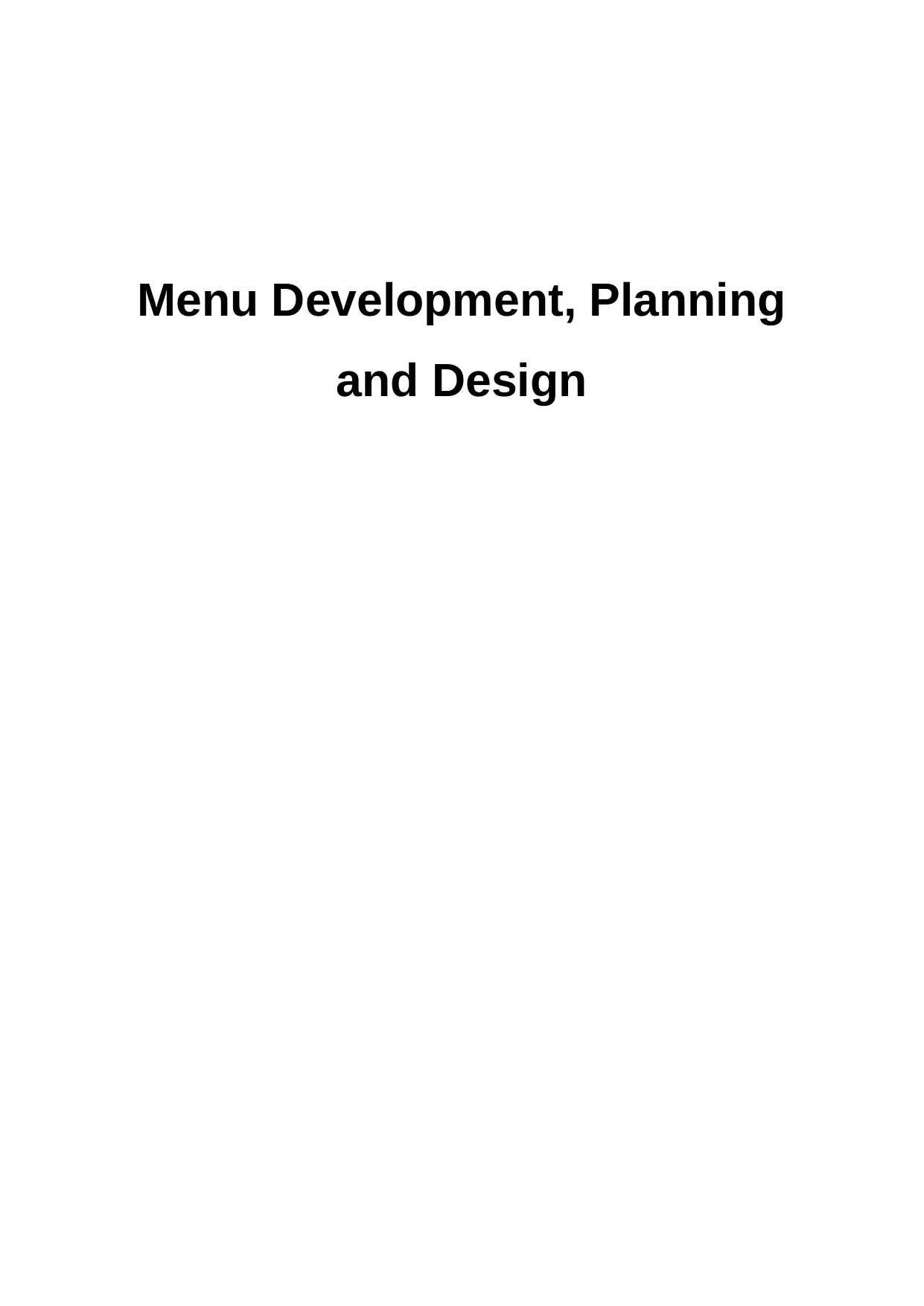
Menu Development, Planning
and Design
and Design
Paraphrase This Document
Need a fresh take? Get an instant paraphrase of this document with our AI Paraphraser
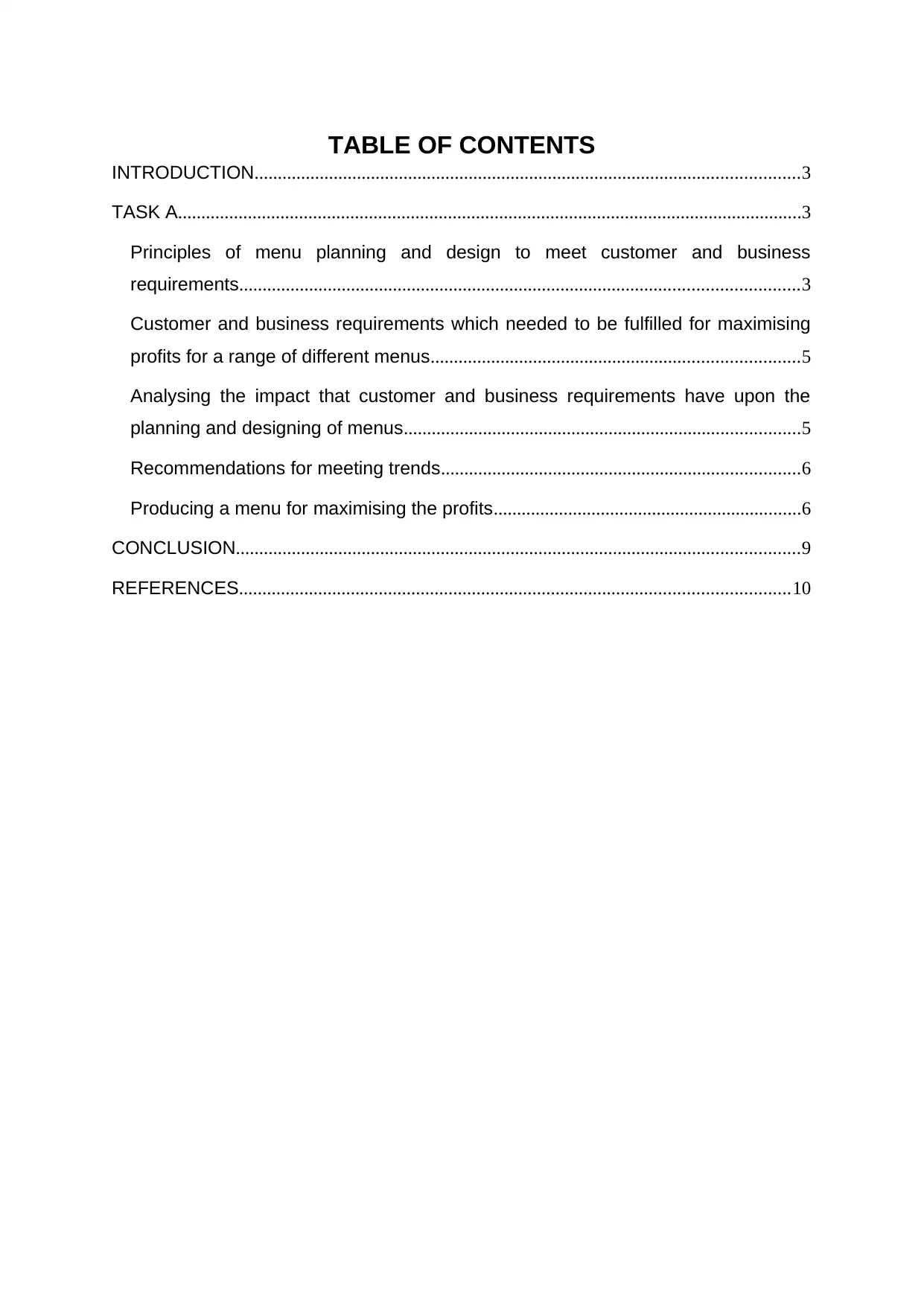
TABLE OF CONTENTS
INTRODUCTION.....................................................................................................................3
TASK A......................................................................................................................................3
Principles of menu planning and design to meet customer and business
requirements........................................................................................................................3
Customer and business requirements which needed to be fulfilled for maximising
profits for a range of different menus...............................................................................5
Analysing the impact that customer and business requirements have upon the
planning and designing of menus.....................................................................................5
Recommendations for meeting trends.............................................................................6
Producing a menu for maximising the profits..................................................................6
CONCLUSION.........................................................................................................................9
REFERENCES......................................................................................................................10
INTRODUCTION.....................................................................................................................3
TASK A......................................................................................................................................3
Principles of menu planning and design to meet customer and business
requirements........................................................................................................................3
Customer and business requirements which needed to be fulfilled for maximising
profits for a range of different menus...............................................................................5
Analysing the impact that customer and business requirements have upon the
planning and designing of menus.....................................................................................5
Recommendations for meeting trends.............................................................................6
Producing a menu for maximising the profits..................................................................6
CONCLUSION.........................................................................................................................9
REFERENCES......................................................................................................................10
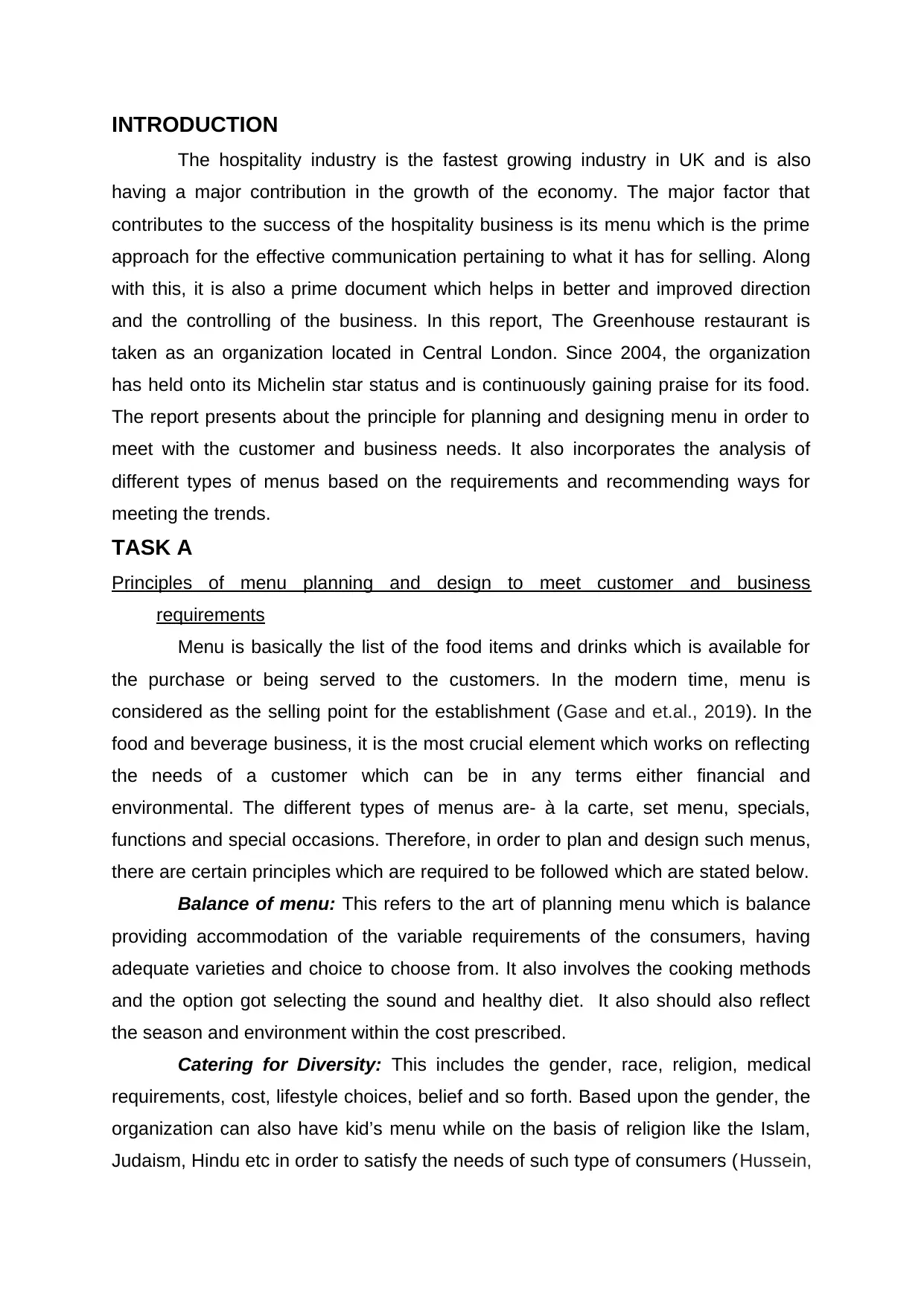
INTRODUCTION
The hospitality industry is the fastest growing industry in UK and is also
having a major contribution in the growth of the economy. The major factor that
contributes to the success of the hospitality business is its menu which is the prime
approach for the effective communication pertaining to what it has for selling. Along
with this, it is also a prime document which helps in better and improved direction
and the controlling of the business. In this report, The Greenhouse restaurant is
taken as an organization located in Central London. Since 2004, the organization
has held onto its Michelin star status and is continuously gaining praise for its food.
The report presents about the principle for planning and designing menu in order to
meet with the customer and business needs. It also incorporates the analysis of
different types of menus based on the requirements and recommending ways for
meeting the trends.
TASK A
Principles of menu planning and design to meet customer and business
requirements
Menu is basically the list of the food items and drinks which is available for
the purchase or being served to the customers. In the modern time, menu is
considered as the selling point for the establishment (Gase and et.al., 2019). In the
food and beverage business, it is the most crucial element which works on reflecting
the needs of a customer which can be in any terms either financial and
environmental. The different types of menus are- à la carte, set menu, specials,
functions and special occasions. Therefore, in order to plan and design such menus,
there are certain principles which are required to be followed which are stated below.
Balance of menu: This refers to the art of planning menu which is balance
providing accommodation of the variable requirements of the consumers, having
adequate varieties and choice to choose from. It also involves the cooking methods
and the option got selecting the sound and healthy diet. It also should also reflect
the season and environment within the cost prescribed.
Catering for Diversity: This includes the gender, race, religion, medical
requirements, cost, lifestyle choices, belief and so forth. Based upon the gender, the
organization can also have kid’s menu while on the basis of religion like the Islam,
Judaism, Hindu etc in order to satisfy the needs of such type of consumers (Hussein,
The hospitality industry is the fastest growing industry in UK and is also
having a major contribution in the growth of the economy. The major factor that
contributes to the success of the hospitality business is its menu which is the prime
approach for the effective communication pertaining to what it has for selling. Along
with this, it is also a prime document which helps in better and improved direction
and the controlling of the business. In this report, The Greenhouse restaurant is
taken as an organization located in Central London. Since 2004, the organization
has held onto its Michelin star status and is continuously gaining praise for its food.
The report presents about the principle for planning and designing menu in order to
meet with the customer and business needs. It also incorporates the analysis of
different types of menus based on the requirements and recommending ways for
meeting the trends.
TASK A
Principles of menu planning and design to meet customer and business
requirements
Menu is basically the list of the food items and drinks which is available for
the purchase or being served to the customers. In the modern time, menu is
considered as the selling point for the establishment (Gase and et.al., 2019). In the
food and beverage business, it is the most crucial element which works on reflecting
the needs of a customer which can be in any terms either financial and
environmental. The different types of menus are- à la carte, set menu, specials,
functions and special occasions. Therefore, in order to plan and design such menus,
there are certain principles which are required to be followed which are stated below.
Balance of menu: This refers to the art of planning menu which is balance
providing accommodation of the variable requirements of the consumers, having
adequate varieties and choice to choose from. It also involves the cooking methods
and the option got selecting the sound and healthy diet. It also should also reflect
the season and environment within the cost prescribed.
Catering for Diversity: This includes the gender, race, religion, medical
requirements, cost, lifestyle choices, belief and so forth. Based upon the gender, the
organization can also have kid’s menu while on the basis of religion like the Islam,
Judaism, Hindu etc in order to satisfy the needs of such type of consumers (Hussein,
⊘ This is a preview!⊘
Do you want full access?
Subscribe today to unlock all pages.

Trusted by 1+ million students worldwide
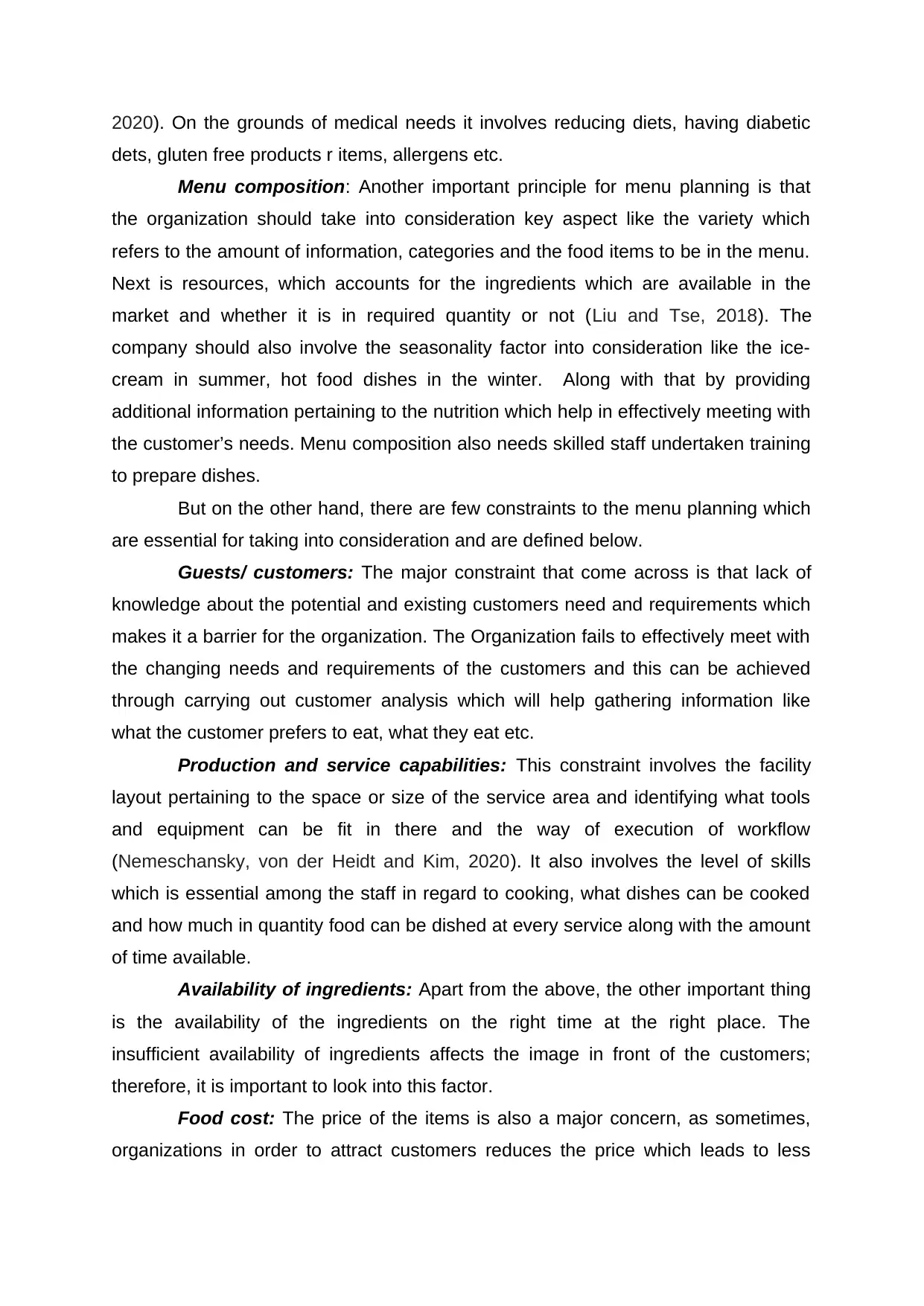
2020). On the grounds of medical needs it involves reducing diets, having diabetic
dets, gluten free products r items, allergens etc.
Menu composition: Another important principle for menu planning is that
the organization should take into consideration key aspect like the variety which
refers to the amount of information, categories and the food items to be in the menu.
Next is resources, which accounts for the ingredients which are available in the
market and whether it is in required quantity or not (Liu and Tse, 2018). The
company should also involve the seasonality factor into consideration like the ice-
cream in summer, hot food dishes in the winter. Along with that by providing
additional information pertaining to the nutrition which help in effectively meeting with
the customer’s needs. Menu composition also needs skilled staff undertaken training
to prepare dishes.
But on the other hand, there are few constraints to the menu planning which
are essential for taking into consideration and are defined below.
Guests/ customers: The major constraint that come across is that lack of
knowledge about the potential and existing customers need and requirements which
makes it a barrier for the organization. The Organization fails to effectively meet with
the changing needs and requirements of the customers and this can be achieved
through carrying out customer analysis which will help gathering information like
what the customer prefers to eat, what they eat etc.
Production and service capabilities: This constraint involves the facility
layout pertaining to the space or size of the service area and identifying what tools
and equipment can be fit in there and the way of execution of workflow
(Nemeschansky, von der Heidt and Kim, 2020). It also involves the level of skills
which is essential among the staff in regard to cooking, what dishes can be cooked
and how much in quantity food can be dished at every service along with the amount
of time available.
Availability of ingredients: Apart from the above, the other important thing
is the availability of the ingredients on the right time at the right place. The
insufficient availability of ingredients affects the image in front of the customers;
therefore, it is important to look into this factor.
Food cost: The price of the items is also a major concern, as sometimes,
organizations in order to attract customers reduces the price which leads to less
dets, gluten free products r items, allergens etc.
Menu composition: Another important principle for menu planning is that
the organization should take into consideration key aspect like the variety which
refers to the amount of information, categories and the food items to be in the menu.
Next is resources, which accounts for the ingredients which are available in the
market and whether it is in required quantity or not (Liu and Tse, 2018). The
company should also involve the seasonality factor into consideration like the ice-
cream in summer, hot food dishes in the winter. Along with that by providing
additional information pertaining to the nutrition which help in effectively meeting with
the customer’s needs. Menu composition also needs skilled staff undertaken training
to prepare dishes.
But on the other hand, there are few constraints to the menu planning which
are essential for taking into consideration and are defined below.
Guests/ customers: The major constraint that come across is that lack of
knowledge about the potential and existing customers need and requirements which
makes it a barrier for the organization. The Organization fails to effectively meet with
the changing needs and requirements of the customers and this can be achieved
through carrying out customer analysis which will help gathering information like
what the customer prefers to eat, what they eat etc.
Production and service capabilities: This constraint involves the facility
layout pertaining to the space or size of the service area and identifying what tools
and equipment can be fit in there and the way of execution of workflow
(Nemeschansky, von der Heidt and Kim, 2020). It also involves the level of skills
which is essential among the staff in regard to cooking, what dishes can be cooked
and how much in quantity food can be dished at every service along with the amount
of time available.
Availability of ingredients: Apart from the above, the other important thing
is the availability of the ingredients on the right time at the right place. The
insufficient availability of ingredients affects the image in front of the customers;
therefore, it is important to look into this factor.
Food cost: The price of the items is also a major concern, as sometimes,
organizations in order to attract customers reduces the price which leads to less
Paraphrase This Document
Need a fresh take? Get an instant paraphrase of this document with our AI Paraphraser
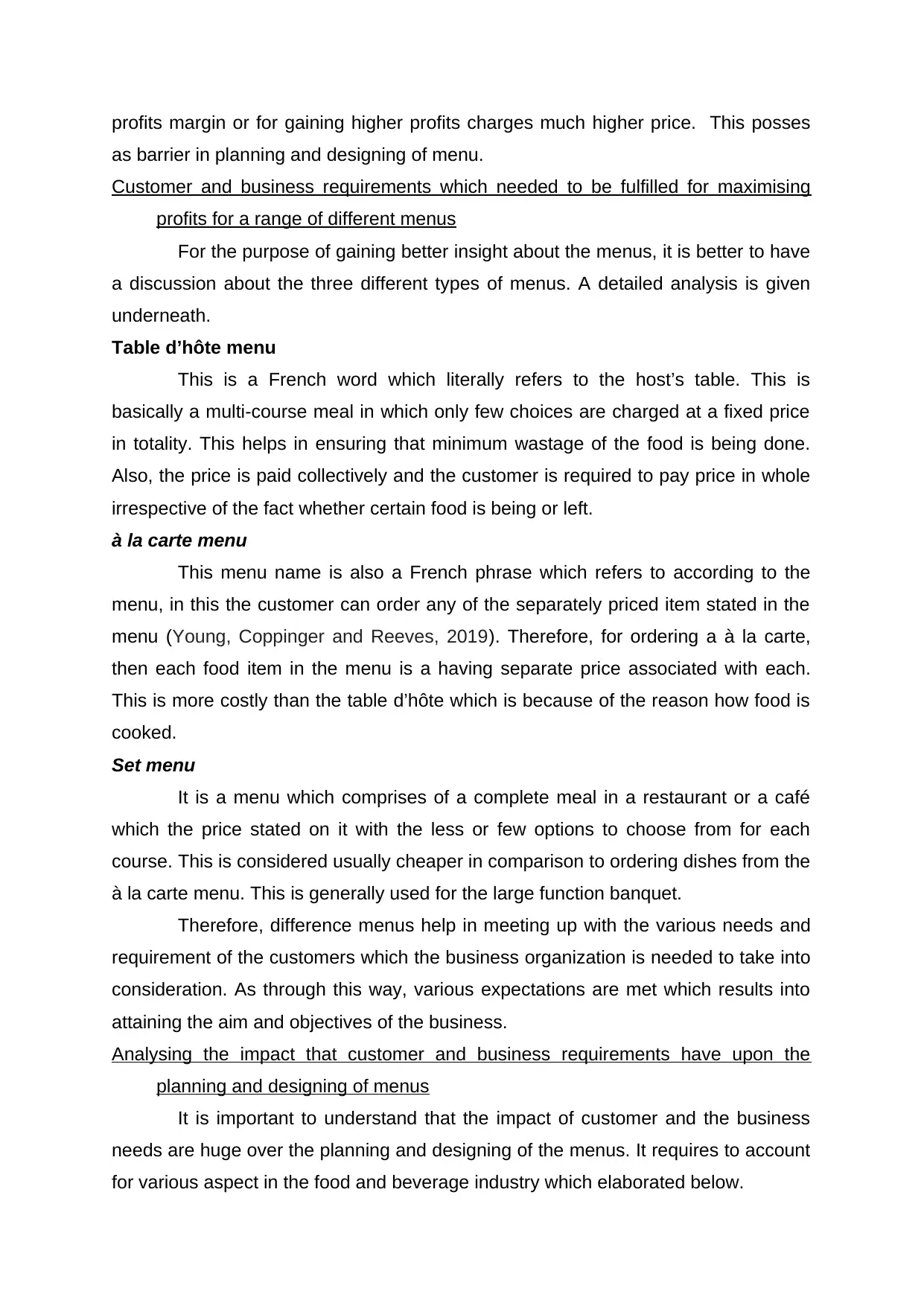
profits margin or for gaining higher profits charges much higher price. This posses
as barrier in planning and designing of menu.
Customer and business requirements which needed to be fulfilled for maximising
profits for a range of different menus
For the purpose of gaining better insight about the menus, it is better to have
a discussion about the three different types of menus. A detailed analysis is given
underneath.
Table d’hôte menu
This is a French word which literally refers to the host’s table. This is
basically a multi-course meal in which only few choices are charged at a fixed price
in totality. This helps in ensuring that minimum wastage of the food is being done.
Also, the price is paid collectively and the customer is required to pay price in whole
irrespective of the fact whether certain food is being or left.
à la carte menu
This menu name is also a French phrase which refers to according to the
menu, in this the customer can order any of the separately priced item stated in the
menu (Young, Coppinger and Reeves, 2019). Therefore, for ordering a à la carte,
then each food item in the menu is a having separate price associated with each.
This is more costly than the table d’hôte which is because of the reason how food is
cooked.
Set menu
It is a menu which comprises of a complete meal in a restaurant or a café
which the price stated on it with the less or few options to choose from for each
course. This is considered usually cheaper in comparison to ordering dishes from the
à la carte menu. This is generally used for the large function banquet.
Therefore, difference menus help in meeting up with the various needs and
requirement of the customers which the business organization is needed to take into
consideration. As through this way, various expectations are met which results into
attaining the aim and objectives of the business.
Analysing the impact that customer and business requirements have upon the
planning and designing of menus
It is important to understand that the impact of customer and the business
needs are huge over the planning and designing of the menus. It requires to account
for various aspect in the food and beverage industry which elaborated below.
as barrier in planning and designing of menu.
Customer and business requirements which needed to be fulfilled for maximising
profits for a range of different menus
For the purpose of gaining better insight about the menus, it is better to have
a discussion about the three different types of menus. A detailed analysis is given
underneath.
Table d’hôte menu
This is a French word which literally refers to the host’s table. This is
basically a multi-course meal in which only few choices are charged at a fixed price
in totality. This helps in ensuring that minimum wastage of the food is being done.
Also, the price is paid collectively and the customer is required to pay price in whole
irrespective of the fact whether certain food is being or left.
à la carte menu
This menu name is also a French phrase which refers to according to the
menu, in this the customer can order any of the separately priced item stated in the
menu (Young, Coppinger and Reeves, 2019). Therefore, for ordering a à la carte,
then each food item in the menu is a having separate price associated with each.
This is more costly than the table d’hôte which is because of the reason how food is
cooked.
Set menu
It is a menu which comprises of a complete meal in a restaurant or a café
which the price stated on it with the less or few options to choose from for each
course. This is considered usually cheaper in comparison to ordering dishes from the
à la carte menu. This is generally used for the large function banquet.
Therefore, difference menus help in meeting up with the various needs and
requirement of the customers which the business organization is needed to take into
consideration. As through this way, various expectations are met which results into
attaining the aim and objectives of the business.
Analysing the impact that customer and business requirements have upon the
planning and designing of menus
It is important to understand that the impact of customer and the business
needs are huge over the planning and designing of the menus. It requires to account
for various aspect in the food and beverage industry which elaborated below.
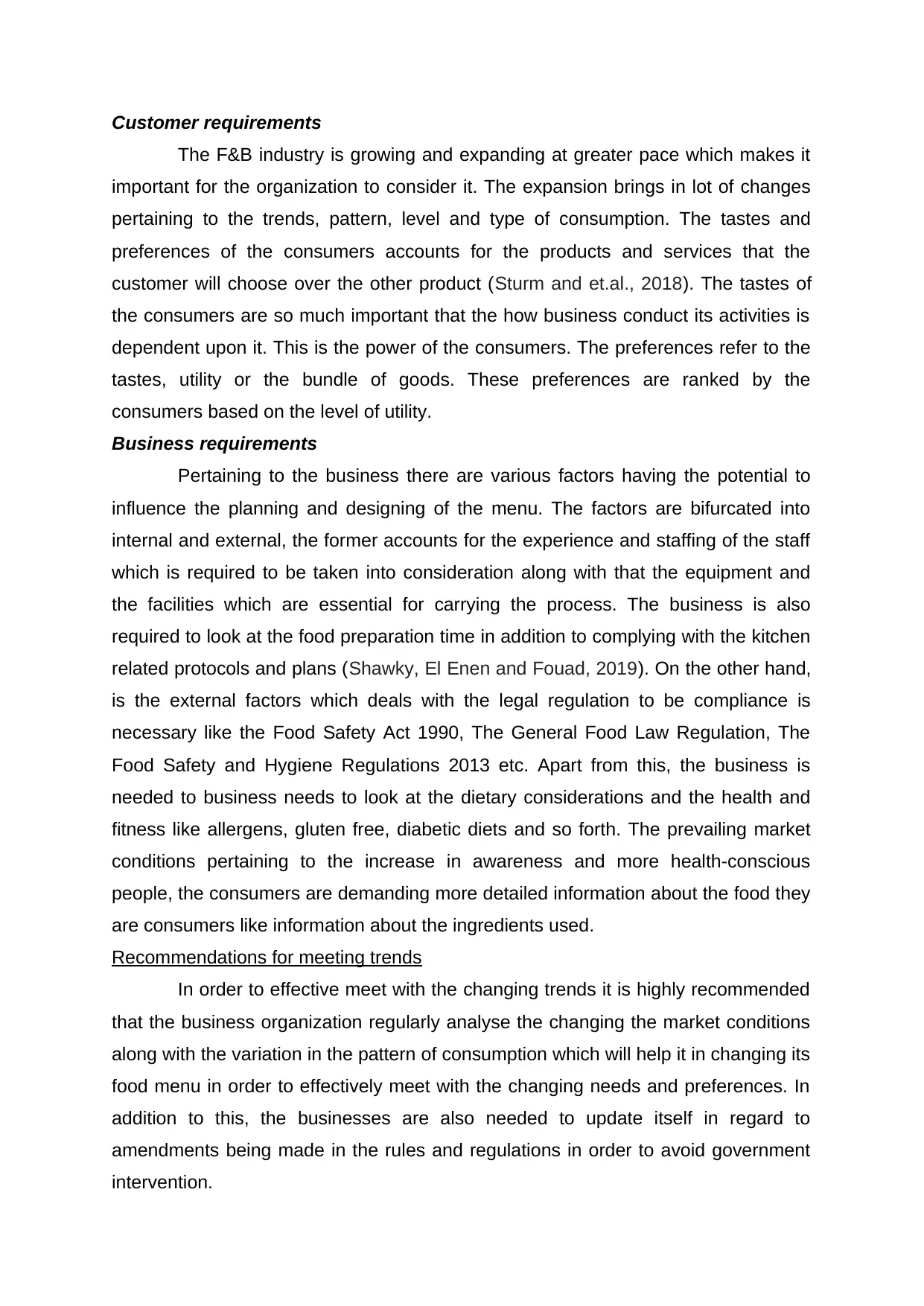
Customer requirements
The F&B industry is growing and expanding at greater pace which makes it
important for the organization to consider it. The expansion brings in lot of changes
pertaining to the trends, pattern, level and type of consumption. The tastes and
preferences of the consumers accounts for the products and services that the
customer will choose over the other product (Sturm and et.al., 2018). The tastes of
the consumers are so much important that the how business conduct its activities is
dependent upon it. This is the power of the consumers. The preferences refer to the
tastes, utility or the bundle of goods. These preferences are ranked by the
consumers based on the level of utility.
Business requirements
Pertaining to the business there are various factors having the potential to
influence the planning and designing of the menu. The factors are bifurcated into
internal and external, the former accounts for the experience and staffing of the staff
which is required to be taken into consideration along with that the equipment and
the facilities which are essential for carrying the process. The business is also
required to look at the food preparation time in addition to complying with the kitchen
related protocols and plans (Shawky, El Enen and Fouad, 2019). On the other hand,
is the external factors which deals with the legal regulation to be compliance is
necessary like the Food Safety Act 1990, The General Food Law Regulation, The
Food Safety and Hygiene Regulations 2013 etc. Apart from this, the business is
needed to business needs to look at the dietary considerations and the health and
fitness like allergens, gluten free, diabetic diets and so forth. The prevailing market
conditions pertaining to the increase in awareness and more health-conscious
people, the consumers are demanding more detailed information about the food they
are consumers like information about the ingredients used.
Recommendations for meeting trends
In order to effective meet with the changing trends it is highly recommended
that the business organization regularly analyse the changing the market conditions
along with the variation in the pattern of consumption which will help it in changing its
food menu in order to effectively meet with the changing needs and preferences. In
addition to this, the businesses are also needed to update itself in regard to
amendments being made in the rules and regulations in order to avoid government
intervention.
The F&B industry is growing and expanding at greater pace which makes it
important for the organization to consider it. The expansion brings in lot of changes
pertaining to the trends, pattern, level and type of consumption. The tastes and
preferences of the consumers accounts for the products and services that the
customer will choose over the other product (Sturm and et.al., 2018). The tastes of
the consumers are so much important that the how business conduct its activities is
dependent upon it. This is the power of the consumers. The preferences refer to the
tastes, utility or the bundle of goods. These preferences are ranked by the
consumers based on the level of utility.
Business requirements
Pertaining to the business there are various factors having the potential to
influence the planning and designing of the menu. The factors are bifurcated into
internal and external, the former accounts for the experience and staffing of the staff
which is required to be taken into consideration along with that the equipment and
the facilities which are essential for carrying the process. The business is also
required to look at the food preparation time in addition to complying with the kitchen
related protocols and plans (Shawky, El Enen and Fouad, 2019). On the other hand,
is the external factors which deals with the legal regulation to be compliance is
necessary like the Food Safety Act 1990, The General Food Law Regulation, The
Food Safety and Hygiene Regulations 2013 etc. Apart from this, the business is
needed to business needs to look at the dietary considerations and the health and
fitness like allergens, gluten free, diabetic diets and so forth. The prevailing market
conditions pertaining to the increase in awareness and more health-conscious
people, the consumers are demanding more detailed information about the food they
are consumers like information about the ingredients used.
Recommendations for meeting trends
In order to effective meet with the changing trends it is highly recommended
that the business organization regularly analyse the changing the market conditions
along with the variation in the pattern of consumption which will help it in changing its
food menu in order to effectively meet with the changing needs and preferences. In
addition to this, the businesses are also needed to update itself in regard to
amendments being made in the rules and regulations in order to avoid government
intervention.
⊘ This is a preview!⊘
Do you want full access?
Subscribe today to unlock all pages.

Trusted by 1+ million students worldwide
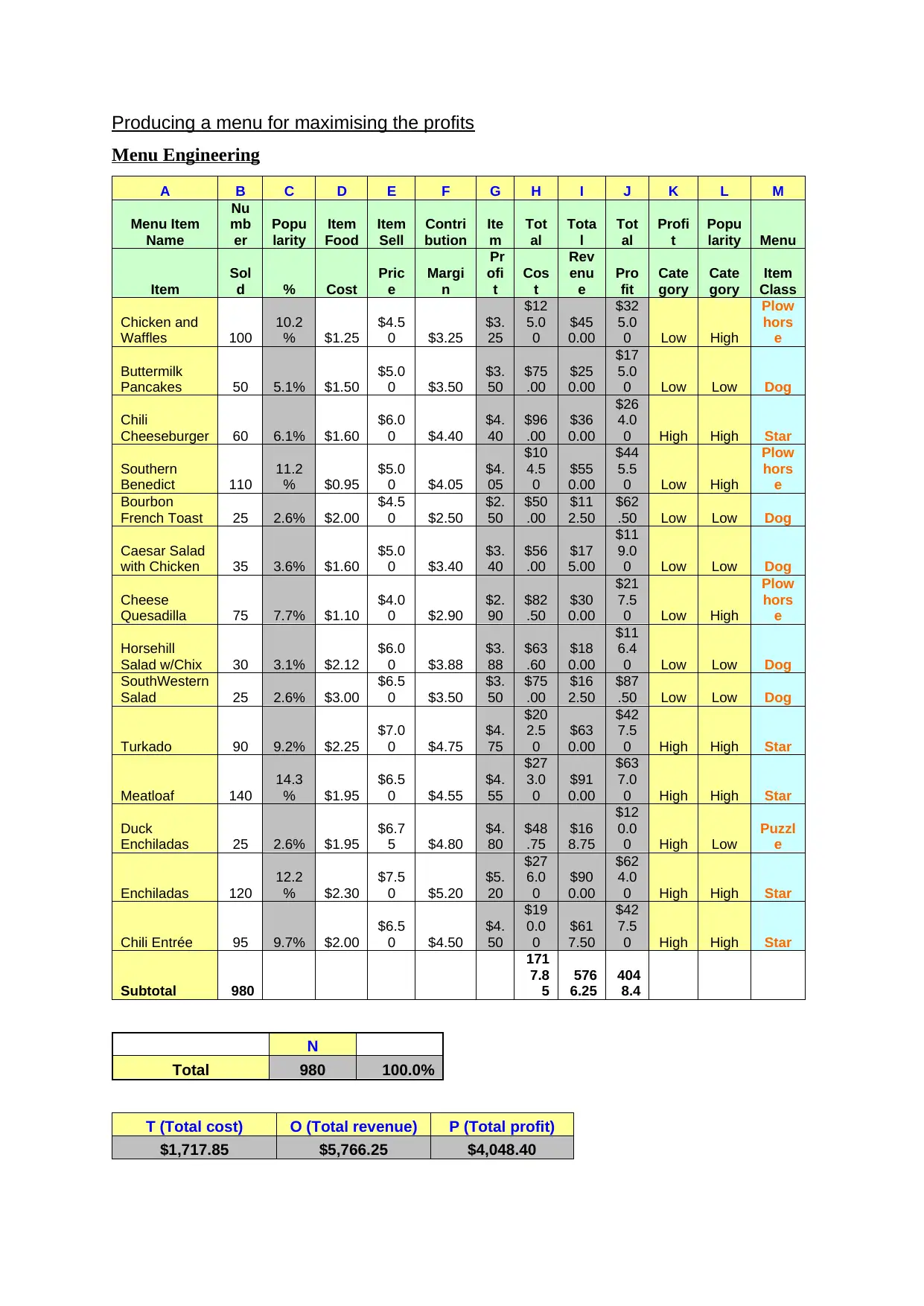
Producing a menu for maximising the profits
Menu Engineering
A B C D E F G H I J K L M
Menu Item
Name
Nu
mb
er
Popu
larity
Item
Food
Item
Sell
Contri
bution
Ite
m
Tot
al
Tota
l
Tot
al
Profi
t
Popu
larity Menu
Item
Sol
d % Cost
Pric
e
Margi
n
Pr
ofi
t
Cos
t
Rev
enu
e
Pro
fit
Cate
gory
Cate
gory
Item
Class
Chicken and
Waffles 100
10.2
% $1.25
$4.5
0 $3.25
$3.
25
$12
5.0
0
$45
0.00
$32
5.0
0 Low High
Plow
hors
e
Buttermilk
Pancakes 50 5.1% $1.50
$5.0
0 $3.50
$3.
50
$75
.00
$25
0.00
$17
5.0
0 Low Low Dog
Chili
Cheeseburger 60 6.1% $1.60
$6.0
0 $4.40
$4.
40
$96
.00
$36
0.00
$26
4.0
0 High High Star
Southern
Benedict 110
11.2
% $0.95
$5.0
0 $4.05
$4.
05
$10
4.5
0
$55
0.00
$44
5.5
0 Low High
Plow
hors
e
Bourbon
French Toast 25 2.6% $2.00
$4.5
0 $2.50
$2.
50
$50
.00
$11
2.50
$62
.50 Low Low Dog
Caesar Salad
with Chicken 35 3.6% $1.60
$5.0
0 $3.40
$3.
40
$56
.00
$17
5.00
$11
9.0
0 Low Low Dog
Cheese
Quesadilla 75 7.7% $1.10
$4.0
0 $2.90
$2.
90
$82
.50
$30
0.00
$21
7.5
0 Low High
Plow
hors
e
Horsehill
Salad w/Chix 30 3.1% $2.12
$6.0
0 $3.88
$3.
88
$63
.60
$18
0.00
$11
6.4
0 Low Low Dog
SouthWestern
Salad 25 2.6% $3.00
$6.5
0 $3.50
$3.
50
$75
.00
$16
2.50
$87
.50 Low Low Dog
Turkado 90 9.2% $2.25
$7.0
0 $4.75
$4.
75
$20
2.5
0
$63
0.00
$42
7.5
0 High High Star
Meatloaf 140
14.3
% $1.95
$6.5
0 $4.55
$4.
55
$27
3.0
0
$91
0.00
$63
7.0
0 High High Star
Duck
Enchiladas 25 2.6% $1.95
$6.7
5 $4.80
$4.
80
$48
.75
$16
8.75
$12
0.0
0 High Low
Puzzl
e
Enchiladas 120
12.2
% $2.30
$7.5
0 $5.20
$5.
20
$27
6.0
0
$90
0.00
$62
4.0
0 High High Star
Chili Entrée 95 9.7% $2.00
$6.5
0 $4.50
$4.
50
$19
0.0
0
$61
7.50
$42
7.5
0 High High Star
Subtotal 980
171
7.8
5
576
6.25
404
8.4
N
Total 980 100.0%
T (Total cost) O (Total revenue) P (Total profit)
$1,717.85 $5,766.25 $4,048.40
Menu Engineering
A B C D E F G H I J K L M
Menu Item
Name
Nu
mb
er
Popu
larity
Item
Food
Item
Sell
Contri
bution
Ite
m
Tot
al
Tota
l
Tot
al
Profi
t
Popu
larity Menu
Item
Sol
d % Cost
Pric
e
Margi
n
Pr
ofi
t
Cos
t
Rev
enu
e
Pro
fit
Cate
gory
Cate
gory
Item
Class
Chicken and
Waffles 100
10.2
% $1.25
$4.5
0 $3.25
$3.
25
$12
5.0
0
$45
0.00
$32
5.0
0 Low High
Plow
hors
e
Buttermilk
Pancakes 50 5.1% $1.50
$5.0
0 $3.50
$3.
50
$75
.00
$25
0.00
$17
5.0
0 Low Low Dog
Chili
Cheeseburger 60 6.1% $1.60
$6.0
0 $4.40
$4.
40
$96
.00
$36
0.00
$26
4.0
0 High High Star
Southern
Benedict 110
11.2
% $0.95
$5.0
0 $4.05
$4.
05
$10
4.5
0
$55
0.00
$44
5.5
0 Low High
Plow
hors
e
Bourbon
French Toast 25 2.6% $2.00
$4.5
0 $2.50
$2.
50
$50
.00
$11
2.50
$62
.50 Low Low Dog
Caesar Salad
with Chicken 35 3.6% $1.60
$5.0
0 $3.40
$3.
40
$56
.00
$17
5.00
$11
9.0
0 Low Low Dog
Cheese
Quesadilla 75 7.7% $1.10
$4.0
0 $2.90
$2.
90
$82
.50
$30
0.00
$21
7.5
0 Low High
Plow
hors
e
Horsehill
Salad w/Chix 30 3.1% $2.12
$6.0
0 $3.88
$3.
88
$63
.60
$18
0.00
$11
6.4
0 Low Low Dog
SouthWestern
Salad 25 2.6% $3.00
$6.5
0 $3.50
$3.
50
$75
.00
$16
2.50
$87
.50 Low Low Dog
Turkado 90 9.2% $2.25
$7.0
0 $4.75
$4.
75
$20
2.5
0
$63
0.00
$42
7.5
0 High High Star
Meatloaf 140
14.3
% $1.95
$6.5
0 $4.55
$4.
55
$27
3.0
0
$91
0.00
$63
7.0
0 High High Star
Duck
Enchiladas 25 2.6% $1.95
$6.7
5 $4.80
$4.
80
$48
.75
$16
8.75
$12
0.0
0 High Low
Puzzl
e
Enchiladas 120
12.2
% $2.30
$7.5
0 $5.20
$5.
20
$27
6.0
0
$90
0.00
$62
4.0
0 High High Star
Chili Entrée 95 9.7% $2.00
$6.5
0 $4.50
$4.
50
$19
0.0
0
$61
7.50
$42
7.5
0 High High Star
Subtotal 980
171
7.8
5
576
6.25
404
8.4
N
Total 980 100.0%
T (Total cost) O (Total revenue) P (Total profit)
$1,717.85 $5,766.25 $4,048.40
Paraphrase This Document
Need a fresh take? Get an instant paraphrase of this document with our AI Paraphraser
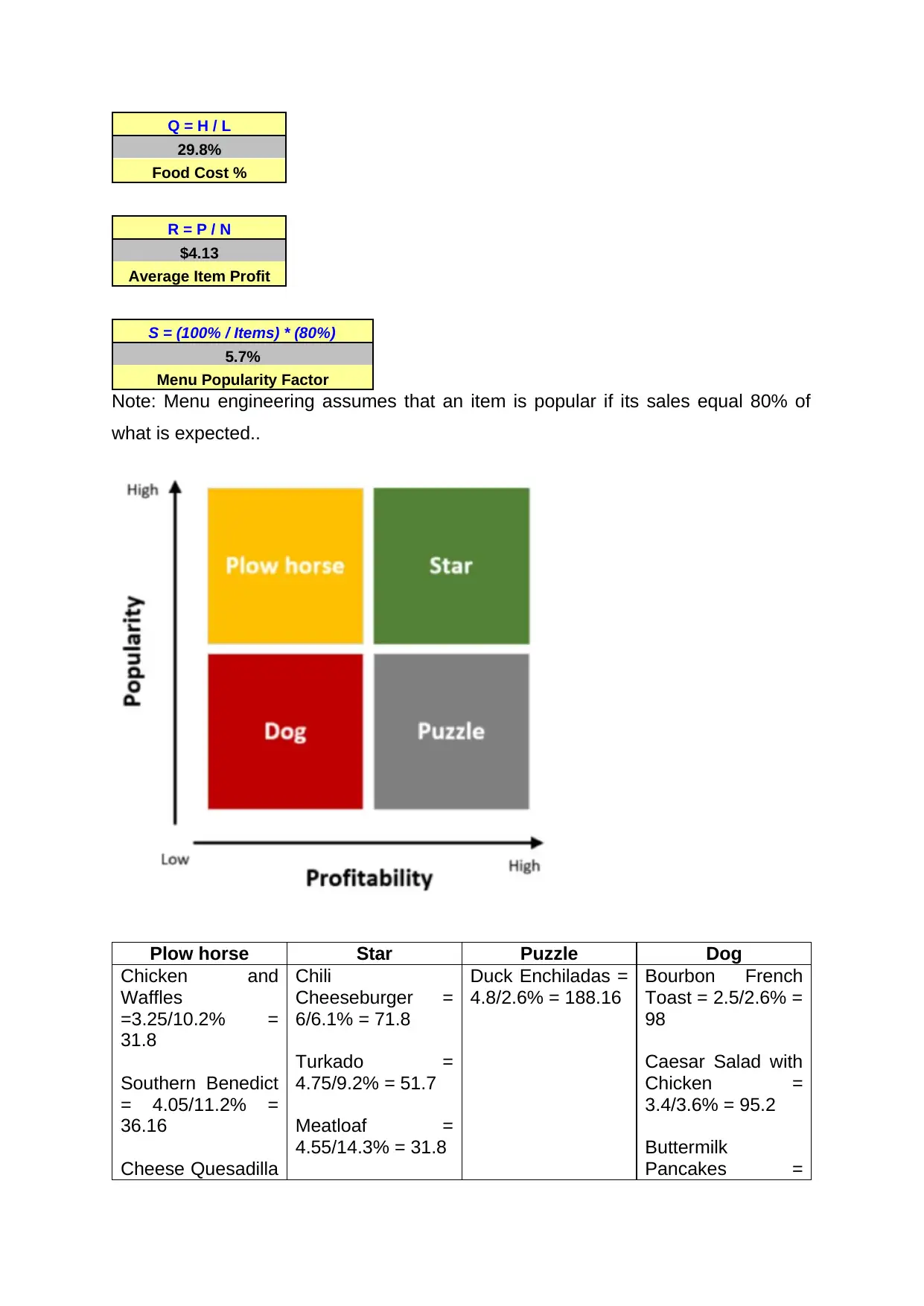
Q = H / L
29.8%
Food Cost %
R = P / N
$4.13
Average Item Profit
S = (100% / Items) * (80%)
5.7%
Menu Popularity Factor
Note: Menu engineering assumes that an item is popular if its sales equal 80% of
what is expected..
Plow horse Star Puzzle Dog
Chicken and
Waffles
=3.25/10.2% =
31.8
Southern Benedict
= 4.05/11.2% =
36.16
Cheese Quesadilla
Chili
Cheeseburger =
6/6.1% = 71.8
Turkado =
4.75/9.2% = 51.7
Meatloaf =
4.55/14.3% = 31.8
Duck Enchiladas =
4.8/2.6% = 188.16
Bourbon French
Toast = 2.5/2.6% =
98
Caesar Salad with
Chicken =
3.4/3.6% = 95.2
Buttermilk
Pancakes =
29.8%
Food Cost %
R = P / N
$4.13
Average Item Profit
S = (100% / Items) * (80%)
5.7%
Menu Popularity Factor
Note: Menu engineering assumes that an item is popular if its sales equal 80% of
what is expected..
Plow horse Star Puzzle Dog
Chicken and
Waffles
=3.25/10.2% =
31.8
Southern Benedict
= 4.05/11.2% =
36.16
Cheese Quesadilla
Chili
Cheeseburger =
6/6.1% = 71.8
Turkado =
4.75/9.2% = 51.7
Meatloaf =
4.55/14.3% = 31.8
Duck Enchiladas =
4.8/2.6% = 188.16
Bourbon French
Toast = 2.5/2.6% =
98
Caesar Salad with
Chicken =
3.4/3.6% = 95.2
Buttermilk
Pancakes =
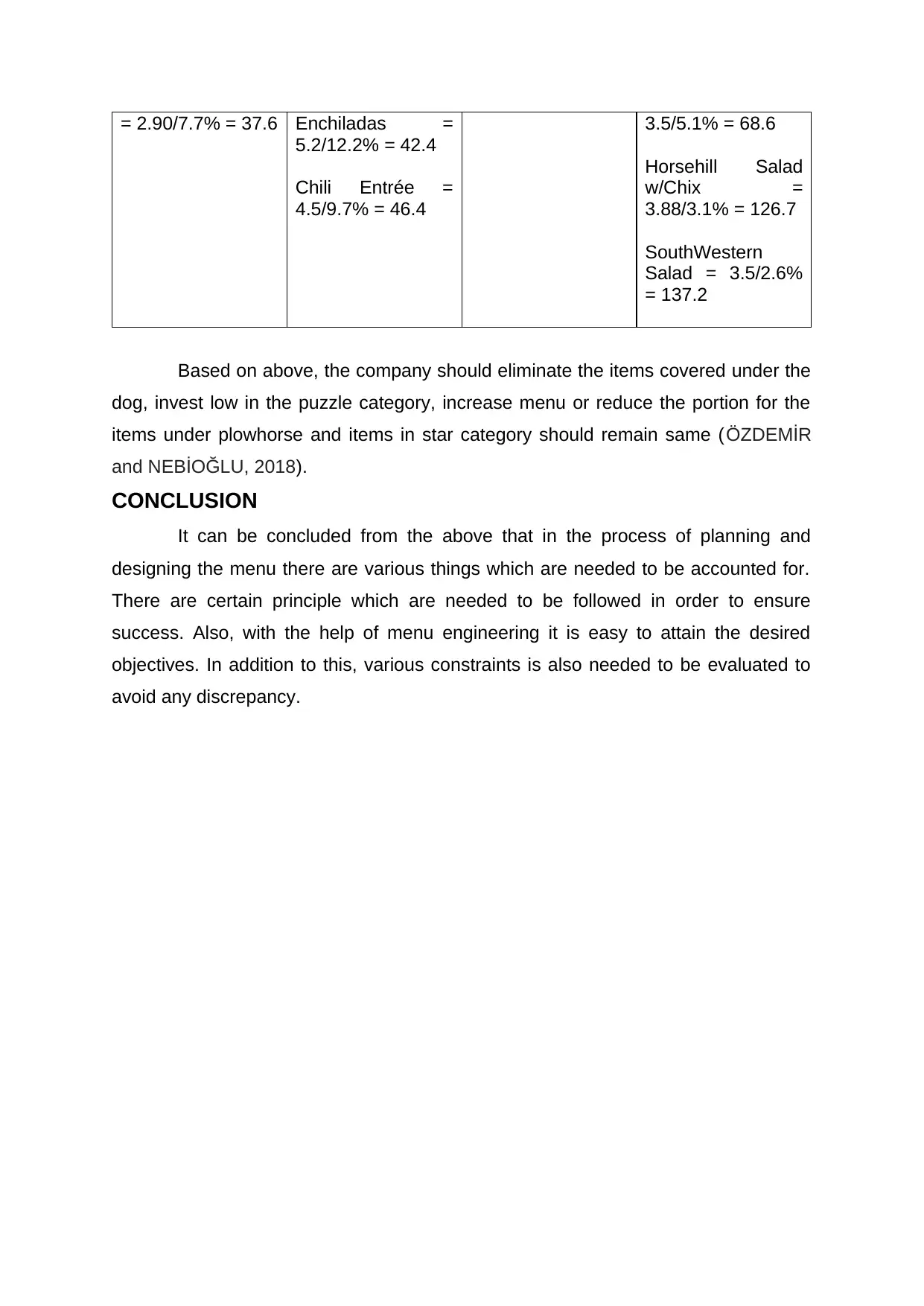
= 2.90/7.7% = 37.6 Enchiladas =
5.2/12.2% = 42.4
Chili Entrée =
4.5/9.7% = 46.4
3.5/5.1% = 68.6
Horsehill Salad
w/Chix =
3.88/3.1% = 126.7
SouthWestern
Salad = 3.5/2.6%
= 137.2
Based on above, the company should eliminate the items covered under the
dog, invest low in the puzzle category, increase menu or reduce the portion for the
items under plowhorse and items in star category should remain same (ÖZDEMİR
and NEBİOĞLU, 2018).
CONCLUSION
It can be concluded from the above that in the process of planning and
designing the menu there are various things which are needed to be accounted for.
There are certain principle which are needed to be followed in order to ensure
success. Also, with the help of menu engineering it is easy to attain the desired
objectives. In addition to this, various constraints is also needed to be evaluated to
avoid any discrepancy.
5.2/12.2% = 42.4
Chili Entrée =
4.5/9.7% = 46.4
3.5/5.1% = 68.6
Horsehill Salad
w/Chix =
3.88/3.1% = 126.7
SouthWestern
Salad = 3.5/2.6%
= 137.2
Based on above, the company should eliminate the items covered under the
dog, invest low in the puzzle category, increase menu or reduce the portion for the
items under plowhorse and items in star category should remain same (ÖZDEMİR
and NEBİOĞLU, 2018).
CONCLUSION
It can be concluded from the above that in the process of planning and
designing the menu there are various things which are needed to be accounted for.
There are certain principle which are needed to be followed in order to ensure
success. Also, with the help of menu engineering it is easy to attain the desired
objectives. In addition to this, various constraints is also needed to be evaluated to
avoid any discrepancy.
⊘ This is a preview!⊘
Do you want full access?
Subscribe today to unlock all pages.

Trusted by 1+ million students worldwide
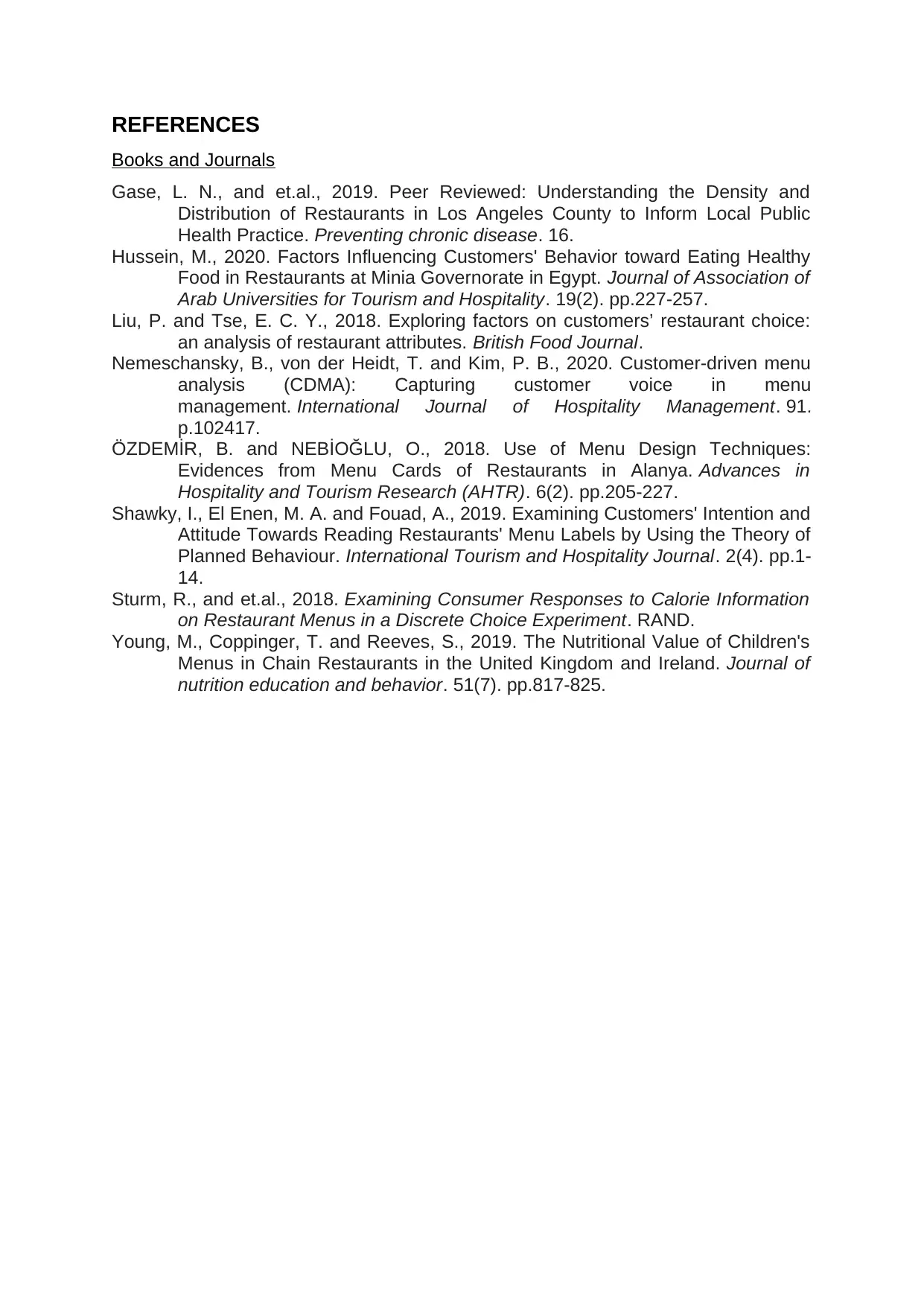
REFERENCES
Books and Journals
Gase, L. N., and et.al., 2019. Peer Reviewed: Understanding the Density and
Distribution of Restaurants in Los Angeles County to Inform Local Public
Health Practice. Preventing chronic disease. 16.
Hussein, M., 2020. Factors Influencing Customers' Behavior toward Eating Healthy
Food in Restaurants at Minia Governorate in Egypt. Journal of Association of
Arab Universities for Tourism and Hospitality. 19(2). pp.227-257.
Liu, P. and Tse, E. C. Y., 2018. Exploring factors on customers’ restaurant choice:
an analysis of restaurant attributes. British Food Journal.
Nemeschansky, B., von der Heidt, T. and Kim, P. B., 2020. Customer-driven menu
analysis (CDMA): Capturing customer voice in menu
management. International Journal of Hospitality Management. 91.
p.102417.
ÖZDEMİR, B. and NEBİOĞLU, O., 2018. Use of Menu Design Techniques:
Evidences from Menu Cards of Restaurants in Alanya. Advances in
Hospitality and Tourism Research (AHTR). 6(2). pp.205-227.
Shawky, I., El Enen, M. A. and Fouad, A., 2019. Examining Customers' Intention and
Attitude Towards Reading Restaurants' Menu Labels by Using the Theory of
Planned Behaviour. International Tourism and Hospitality Journal. 2(4). pp.1-
14.
Sturm, R., and et.al., 2018. Examining Consumer Responses to Calorie Information
on Restaurant Menus in a Discrete Choice Experiment. RAND.
Young, M., Coppinger, T. and Reeves, S., 2019. The Nutritional Value of Children's
Menus in Chain Restaurants in the United Kingdom and Ireland. Journal of
nutrition education and behavior. 51(7). pp.817-825.
Books and Journals
Gase, L. N., and et.al., 2019. Peer Reviewed: Understanding the Density and
Distribution of Restaurants in Los Angeles County to Inform Local Public
Health Practice. Preventing chronic disease. 16.
Hussein, M., 2020. Factors Influencing Customers' Behavior toward Eating Healthy
Food in Restaurants at Minia Governorate in Egypt. Journal of Association of
Arab Universities for Tourism and Hospitality. 19(2). pp.227-257.
Liu, P. and Tse, E. C. Y., 2018. Exploring factors on customers’ restaurant choice:
an analysis of restaurant attributes. British Food Journal.
Nemeschansky, B., von der Heidt, T. and Kim, P. B., 2020. Customer-driven menu
analysis (CDMA): Capturing customer voice in menu
management. International Journal of Hospitality Management. 91.
p.102417.
ÖZDEMİR, B. and NEBİOĞLU, O., 2018. Use of Menu Design Techniques:
Evidences from Menu Cards of Restaurants in Alanya. Advances in
Hospitality and Tourism Research (AHTR). 6(2). pp.205-227.
Shawky, I., El Enen, M. A. and Fouad, A., 2019. Examining Customers' Intention and
Attitude Towards Reading Restaurants' Menu Labels by Using the Theory of
Planned Behaviour. International Tourism and Hospitality Journal. 2(4). pp.1-
14.
Sturm, R., and et.al., 2018. Examining Consumer Responses to Calorie Information
on Restaurant Menus in a Discrete Choice Experiment. RAND.
Young, M., Coppinger, T. and Reeves, S., 2019. The Nutritional Value of Children's
Menus in Chain Restaurants in the United Kingdom and Ireland. Journal of
nutrition education and behavior. 51(7). pp.817-825.
1 out of 10
Related Documents
Your All-in-One AI-Powered Toolkit for Academic Success.
+13062052269
info@desklib.com
Available 24*7 on WhatsApp / Email
![[object Object]](/_next/static/media/star-bottom.7253800d.svg)
Unlock your academic potential
Copyright © 2020–2025 A2Z Services. All Rights Reserved. Developed and managed by ZUCOL.




